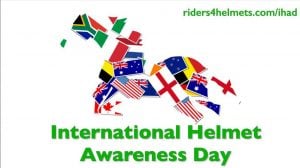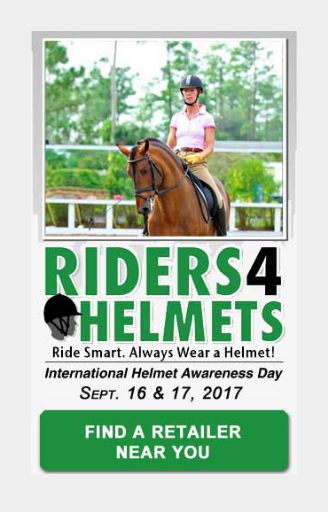Have you taken a tumble in your helmet? Is your helmet more than 4-5 years old? Or do you just really need a helmet in a different colour to match your favourite show outfit? If you have answered yes to any of the above, you are in luck. 16 & 17 September is International Helmet Awareness weekend and you can replace your helmet at a discounted price at any participating retailer.
The Story Behind The Initiative
At the 2008 Olympics, Courtney King-Dye was the youngest member of the United States dressage team and considered one of her country’s riding international stars with a bright future ahead. On 3 March 2010, that future changed.
Courtney says, “I didn’t fall off, and my horse did nothing naughty. He just tripped over his own feet and fell, and my head hit the ground hard. Hence my motto: expect the unexpected. I was not wearing a helmet, and my brain sheered, or bounced around, in my skull.”
Courtney was not wearing a helmet at the time and sustained what the medical community call a TBI (traumatic brain injury). “I was in a coma for a month. I had to relearn to do things like walk, talk and eat.” Seven years down the line, her life is significantly different to what it once was, but she does have a life and now encourages other equestrians to take sensible precautions.
Riders4Helmets
The Riders4Helmets campaign was formed in the wake of Courtney’s tragic accident and they held their first National Helmet Awareness Day on 10 July 2010. The initiative was endorsed by the US Equestrian Federation and Riders4Helmets had a stall at the Kentucky Horse Park, where supporters included Eclipse Award winning jockey Frankie Lovato Jr. More than 200 equestrian retailers and a number of helmet manufacturers came on board offering discounts on helmet purchases and it was such a success and attracted so much interest from around the world that the following year, Helmet Awareness Day went global. It is now in its 8th year and garners support from manufacturers and retailers across the world to offer special discounts on safety headgear.
In South Africa in particular, it’s not just good sense, it’s the rule. With regards to skull caps, the NHA rules read as follows:-
58.9.1 Every PERSON when riding a HORSE, shall wear a serviceable skull cap of a type approved by the CHIEF EXECUTIVE.
However, no matter which discipline you ride, helmets are always a good idea.
Top Tips
Riders4Helmets published the following 10 important messages that all riders should keep in mind on a daily basis:-
- If you have a hard impact blow while wearing your hat, immediately replace it with a new hat. There may be damage to the hat that is not visible to the naked eye.
- Hat manufacturers generally recommend replacing your hat every four to five years. Hats take a beating over time from sweat, heat, dust and rain, and the Styrofoam in the hat relinquishes its ability to protect the head over time. Replacing your hat sooner than four to five years may in some circumstances be necessary.
- A ponytail or different hairstyle can affect the fit of your hat. When you try on hats prior to purchase, wear your hair in the style that you expect to wear it when riding.
- If you purchase your hat online, check the date of manufacture. Purchasing a used hat can be very risky and is NOT recommended. The hat may have sustained previous damage that you aren’t able to see.
- There is no statistical correlation between skill level and injury likelihood. Professional riders are just as at risk to sustain injury due to a fall as less frequent riders.
- Even a fall from a standing horse can be catastrophic. Your injury risk depends on the height from which fall, as well as the speed at which you’re traveling.
- Head injuries are cumulative. An original head injury can be made much worse by additional concussions.
- Riding is considered more dangerous than downhill skiing and motorcycling.
- Approximately 20% of accidents which result in head injury happen while the person is on the ground.
- An incorrectly fitting hat offers very little, to no protection. In addition to wearing a correctly fitting hat, you must have the harness correctly fastened on your hat. If the harness is not fitting snugly, the hat can rotate should you have a fall and it won’t be able to protect your head to its fullest intention.
As part of riders4helmets International Helmet Awareness Day 2017, tack shops around the globe are offering discounts on helmets this weekend. Click here to find your nearest participating retailer.










